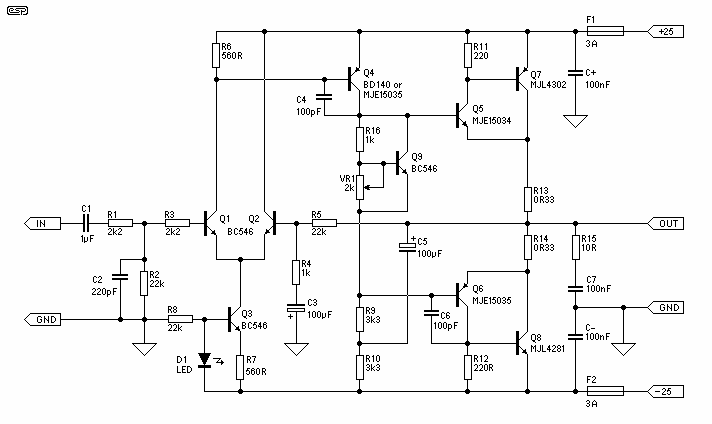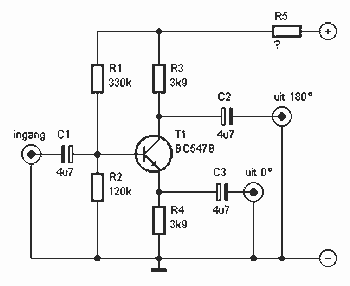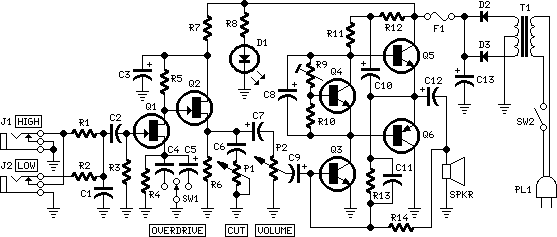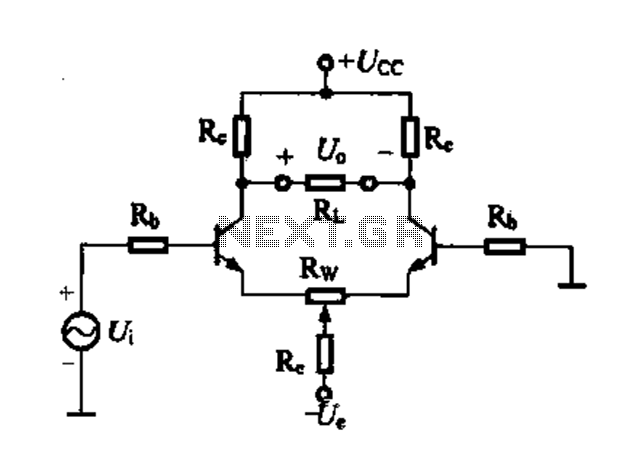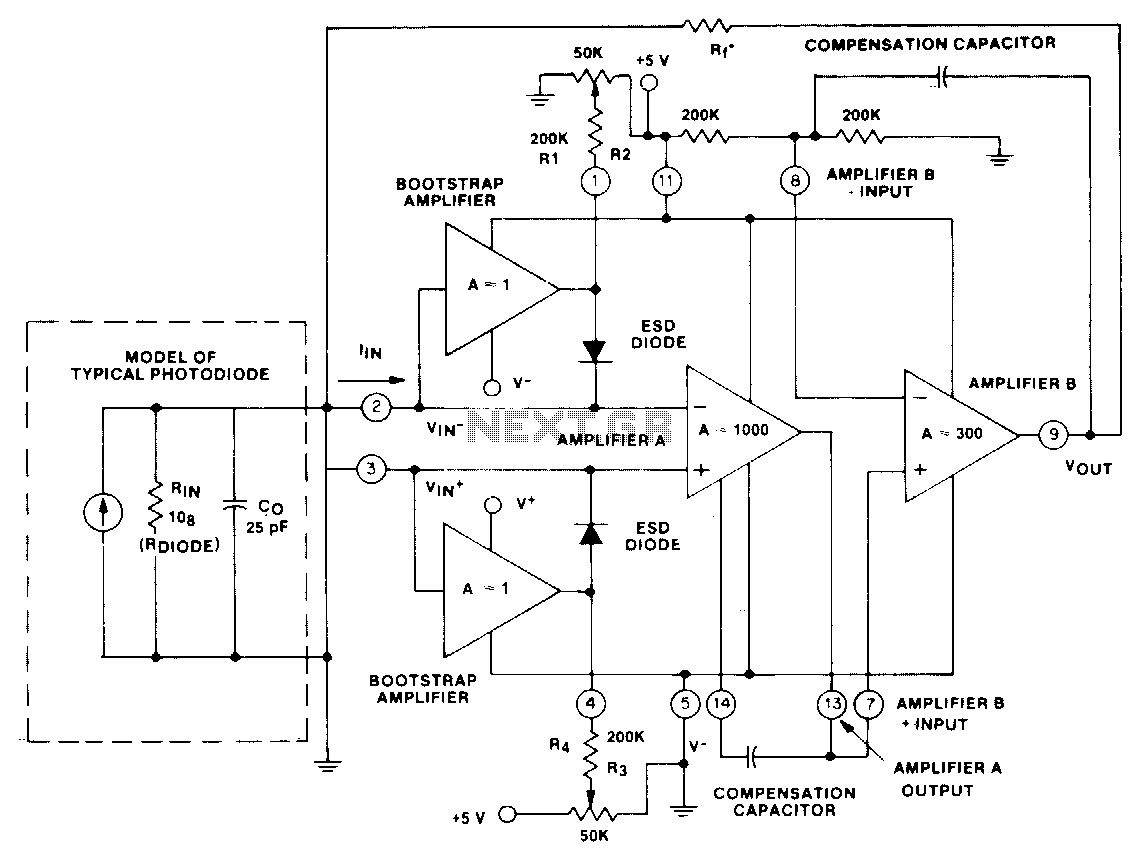
The instrumentation amplifier
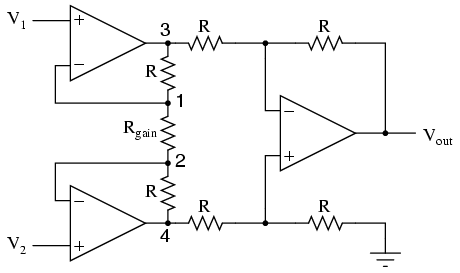
It is advantageous to adjust the gain of an amplifier circuit without modifying more than one resistor value, unlike the previous design of the differential amplifier. The instrumentation amplifier builds upon the last version of the differential amplifier to provide this capability. This circuit is constructed from a buffered differential amplifier stage with three new resistors connecting the two buffer circuits. All resistors are assumed to be of equal value except for Rgain. The negative feedback of the upper-left operational amplifier (op-amp) ensures that the voltage at point 1 (top of Rgain) equals V1, while the voltage at point 2 (bottom of Rgain) equals V2. This creates a voltage drop across Rgain that corresponds to the voltage difference between V1 and V2. This voltage drop generates a current through Rgain, and since the feedback loops of the two input op-amps draw no current, the same current through Rgain must flow through the two resistors labeled "R" above and below it. This results in a voltage drop between points 3 and 4. The standard differential amplifier on the right side of the circuit then amplifies this voltage drop between points 3 and 4 with a gain of 1, assuming all "R" resistors are of equal value. Although this may appear to be a complex method for constructing a differential amplifier, it offers significant advantages such as extremely high input impedances at the V1 and V2 inputs (due to direct connections to the non-inverting inputs of their respective op-amps), and adjustable gain that can be set by a single resistor. By manipulating the formula, a general expression for overall voltage gain in the instrumentation amplifier can be derived. Although not immediately evident from the schematic, the differential gain of the instrumentation amplifier can be altered simply by changing the value of one resistor: Rgain. While it is possible to change the overall gain by adjusting other resistor values, this would require balanced changes to maintain circuit symmetry. The minimum gain achievable with this circuit occurs when Rgain is completely open (infinite resistance), resulting in a gain value of 1. An instrumentation amplifier is a differential op-amp circuit that provides high input impedances and allows for easy gain adjustment through the variation of a single resistor.
The instrumentation amplifier is a sophisticated circuit designed to amplify differential signals while rejecting common-mode noise. It typically employs three operational amplifiers: two op-amps configured as buffers (also known as voltage followers) and one op-amp for the differential amplification stage. The buffered stage ensures that the input signals are isolated from the resistive network, thereby maintaining high input impedance and preventing loading effects on the signal sources.
The three resistors in the circuit play a crucial role in defining the gain of the instrumentation amplifier. The resistor Rgain is the key component that allows for gain adjustment. By varying the resistance of Rgain, the gain of the entire amplifier can be adjusted without affecting the symmetry of the circuit. The gain can be expressed as:
\[ \text{Gain} = 1 + \frac{2R}{R_{gain}} \]
where R represents the value of the resistors connecting the buffer stages. This equation illustrates that the gain can be increased by decreasing the value of Rgain, which in turn increases the differential amplification of the input signals.
The high input impedance of the instrumentation amplifier makes it ideal for applications where the signal source must not be loaded down, such as in sensor applications (e.g., thermocouples, strain gauges). The design also minimizes errors due to voltage drops across the input connections, enhancing measurement accuracy.
In summary, the instrumentation amplifier is a versatile and effective solution for applications requiring precise differential signal amplification with a simple means of gain adjustment. Its architecture, featuring high input impedance and the ability to alter gain through a single resistor, makes it a preferred choice in many electronic measurement and data acquisition systems.As suggested before, it is beneficial to be able to adjust the gain of the amplifier circuit without having to change more than one resistor value, as is necessary with the previous design of differential amplifier. The so-called instrumentation builds on the last version of differential amplifier to give us that capability: This intimidating circ
uit is constructed from a buffered differential amplifier stage with three new resistors linking the two buffer circuits together. Consider all resistors to be of equal value except for Rgain. The negative feedback of the upper-left op-amp causes the voltage at point 1 (top of Rgain) to be equal to V1.
Likewise, the voltage at point 2 (bottom of Rgain) is held to a value equal to V2. This establishes a voltage drop across Rgain equal to the voltage difference between V1 and V2. That voltage drop causes a current through Rgain, and since the feedback loops of the two input op-amps draw no current, that same amount of current through Rgain must be going through the two "R" resistors above and below it. This produces a voltage drop between points 3 and 4 equal to: The regular differential amplifier on the right-hand side of the circuit then takes this voltage drop between points 3 and 4, and amplifies it by a gain of 1 (assuming again that all "R" resistors are of equal value).
Though this looks like a cumbersome way to build a differential amplifier, it has the distinct advantages of possessing extremely high input impedances on the V1 and V2 inputs (because they connect straight into the noninverting inputs of their respective op-amps), and adjustable gain that can be set by a single resistor. Manipulating the above formula a bit, we have a general expression for overall voltage gain in the instrumentation amplifier: Though it may not be obvious by looking at the schematic, we can change the differential gain of the instrumentation amplifier simply by changing the value of one resistor: Rgain.
Yes, we could still change the overall gain by changing the values of some of the other resistors, but this would necessitate balanced resistor value changes for the circuit to remain symmetrical. Please note that the lowest gain possible with the above circuit is obtained with Rgain completely open (infinite resistance), and that gain value is 1.
An instrumentation amplifier is a differential op-amp circuit providing high input impedances with ease of gain adjustment through the variation of a single resistor. 🔗 External reference
The instrumentation amplifier is a sophisticated circuit designed to amplify differential signals while rejecting common-mode noise. It typically employs three operational amplifiers: two op-amps configured as buffers (also known as voltage followers) and one op-amp for the differential amplification stage. The buffered stage ensures that the input signals are isolated from the resistive network, thereby maintaining high input impedance and preventing loading effects on the signal sources.
The three resistors in the circuit play a crucial role in defining the gain of the instrumentation amplifier. The resistor Rgain is the key component that allows for gain adjustment. By varying the resistance of Rgain, the gain of the entire amplifier can be adjusted without affecting the symmetry of the circuit. The gain can be expressed as:
\[ \text{Gain} = 1 + \frac{2R}{R_{gain}} \]
where R represents the value of the resistors connecting the buffer stages. This equation illustrates that the gain can be increased by decreasing the value of Rgain, which in turn increases the differential amplification of the input signals.
The high input impedance of the instrumentation amplifier makes it ideal for applications where the signal source must not be loaded down, such as in sensor applications (e.g., thermocouples, strain gauges). The design also minimizes errors due to voltage drops across the input connections, enhancing measurement accuracy.
In summary, the instrumentation amplifier is a versatile and effective solution for applications requiring precise differential signal amplification with a simple means of gain adjustment. Its architecture, featuring high input impedance and the ability to alter gain through a single resistor, makes it a preferred choice in many electronic measurement and data acquisition systems.As suggested before, it is beneficial to be able to adjust the gain of the amplifier circuit without having to change more than one resistor value, as is necessary with the previous design of differential amplifier. The so-called instrumentation builds on the last version of differential amplifier to give us that capability: This intimidating circ
uit is constructed from a buffered differential amplifier stage with three new resistors linking the two buffer circuits together. Consider all resistors to be of equal value except for Rgain. The negative feedback of the upper-left op-amp causes the voltage at point 1 (top of Rgain) to be equal to V1.
Likewise, the voltage at point 2 (bottom of Rgain) is held to a value equal to V2. This establishes a voltage drop across Rgain equal to the voltage difference between V1 and V2. That voltage drop causes a current through Rgain, and since the feedback loops of the two input op-amps draw no current, that same amount of current through Rgain must be going through the two "R" resistors above and below it. This produces a voltage drop between points 3 and 4 equal to: The regular differential amplifier on the right-hand side of the circuit then takes this voltage drop between points 3 and 4, and amplifies it by a gain of 1 (assuming again that all "R" resistors are of equal value).
Though this looks like a cumbersome way to build a differential amplifier, it has the distinct advantages of possessing extremely high input impedances on the V1 and V2 inputs (because they connect straight into the noninverting inputs of their respective op-amps), and adjustable gain that can be set by a single resistor. Manipulating the above formula a bit, we have a general expression for overall voltage gain in the instrumentation amplifier: Though it may not be obvious by looking at the schematic, we can change the differential gain of the instrumentation amplifier simply by changing the value of one resistor: Rgain.
Yes, we could still change the overall gain by changing the values of some of the other resistors, but this would necessitate balanced resistor value changes for the circuit to remain symmetrical. Please note that the lowest gain possible with the above circuit is obtained with Rgain completely open (infinite resistance), and that gain value is 1.
An instrumentation amplifier is a differential op-amp circuit providing high input impedances with ease of gain adjustment through the variation of a single resistor. 🔗 External reference
Warning: include(partials/cookie-banner.php): Failed to open stream: Permission denied in /var/www/html/nextgr/view-circuit.php on line 713
Warning: include(): Failed opening 'partials/cookie-banner.php' for inclusion (include_path='.:/usr/share/php') in /var/www/html/nextgr/view-circuit.php on line 713
